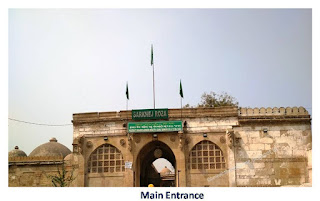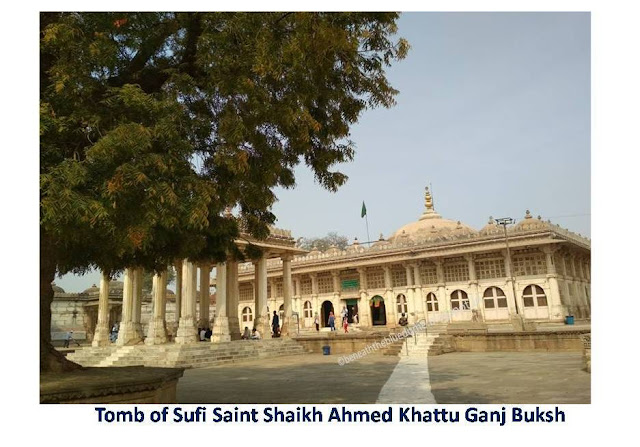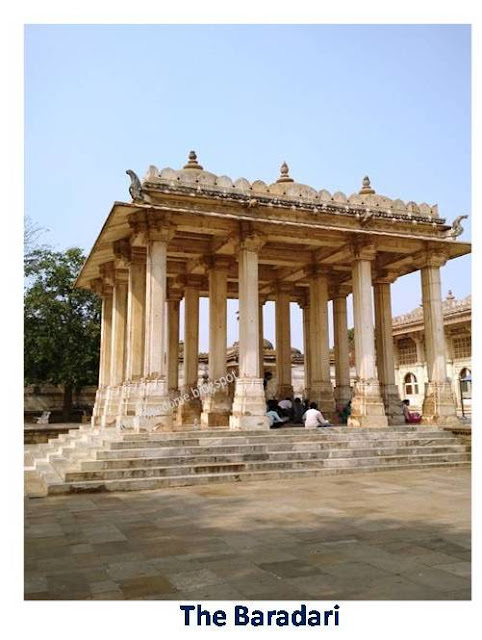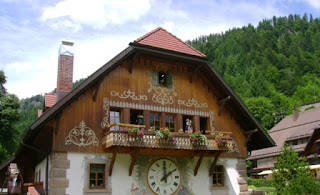Travel Guide to Sarkhej Roza Ahmedabad
Sarkhej Roza, built at the advent of the Sultanate era, is a
place of peace and serenity, with people of all faiths visiting it either to simply spend
quiet time with their families (when we visited, there were a lot of families with their kids) or to offer prayers for the well-being of their
loved ones.
Sarkhej Roza is a unique complex encompassing 34 acres, combining the Persian, Hindu and Jain architectural features to form what is known as "Indo-Saracenic" architectural style.
There is an interesting history behind this complex, displayed on large boards in the aisles within the tomb complex (this info appears at http://sarkhejroza.org/historical_importance.html).
It states as follows -
Features of the Sarkhej Roza Complex
As you enter Sarkhej Roza, on your right is the ablution tank (empty with no water) and the main mausoleum of the Sufi saint.
The commemorative tomb of the Sufi Saint is one of the largest of its kind in the State, with one side measuring 105 ft. At the top, the central dome is surrounded by 13 domes on each side.
This small tomb is a unique specimen of the funerary art of Western India. It consists of a central chamber and side aisles, with 12 pillars supporting the dome enclosed in perforated stone work, with windows overlooking the lake.
Walk ahead beyond the Baradari and you will see the steps leading up to the Jama Masjid.
As per the inscription at the entrance, the main mausoleum is
flanked by a wide terrace overlooking the tank. The central chamber is reached
through two enclosures, each separated by stone trellis work with a balcony
window projecting on the lake side. The central chamber of 12 pillars is
crowned by a single dome and contains the marble graves of Sultan Mahmud Shah I,
his son Sultan Muzzafar Shah II and great grandson Sultan Mahmud Shah III. There are beautiful trellised windows in the aisles, overlooking the tank.
When the tank was
built, it was believed that bathing in it would purify oneself & make one
eligible to enter paradise in the next world. The rectangular tank covers
approximately 17.5 acres of land, with stone steps leading down to the water.
The inlets of water are located at the back of the Jama Masjid.
Jama Masjid Features
At the southwest corner of the Saint’s mausoleum is the Jama Masjid. This has a pillared hall with domes of uniformed height, with minarets conspicuously absent. It is therefore assumed that the mason stone cutters and sculptors were locals, not having imbibed the Saracenic sculptural designs of minarets & arches which are to be found in the architectural style of later buildings.
Conclusion
At Makarba Post,
Jeevraj Park,
Sarkhej,
Ahmedabad
How to reach: You can take your vehicle or an auto. There is parking space outside.
Sarkhej Roza is a unique complex encompassing 34 acres, combining the Persian, Hindu and Jain architectural features to form what is known as "Indo-Saracenic" architectural style.
There is an interesting history behind this complex, displayed on large boards in the aisles within the tomb complex (this info appears at http://sarkhejroza.org/historical_importance.html).
It states as follows -
The History
When Sultan Ahmed Shah ruled the city of Ahmedabad, Sarkhej was a village with the residents mainly being weavers & indigo-dyers. Shaikh Ahmed Khattu Ganj Buksh (Ganj Buksh means bestower of wealth), a highly respected Sufi saint who was an advisor to & friend of the Sultan, spent his later years in Sarkhej and is said to have lived to the ripe age of 111 years. Sultan Mahmud Shah had a mausoleum built in his honor, along with a mosque. His successor, Qutb'ud-Din Ahmed Shah, completed the construction in 1451 A.D. During the latter half of the 15th Century, Sultan Mahmud Begada created a central tank, added pavilions and a small private mosque. It became a family retreat for the Sultans to spend time together and a place to spend quiet time in meditation. On the defeat of Sultan Muzzafar Shah II by Akbar’s army, later additions to the complex included a country house and a garden.
When Sultan Ahmed Shah ruled the city of Ahmedabad, Sarkhej was a village with the residents mainly being weavers & indigo-dyers. Shaikh Ahmed Khattu Ganj Buksh (Ganj Buksh means bestower of wealth), a highly respected Sufi saint who was an advisor to & friend of the Sultan, spent his later years in Sarkhej and is said to have lived to the ripe age of 111 years. Sultan Mahmud Shah had a mausoleum built in his honor, along with a mosque. His successor, Qutb'ud-Din Ahmed Shah, completed the construction in 1451 A.D. During the latter half of the 15th Century, Sultan Mahmud Begada created a central tank, added pavilions and a small private mosque. It became a family retreat for the Sultans to spend time together and a place to spend quiet time in meditation. On the defeat of Sultan Muzzafar Shah II by Akbar’s army, later additions to the complex included a country house and a garden.
Features of the Sarkhej Roza Complex
At the main entrance is a Persian inscription, the
translation of which is:
"When
the ocean of Ahmed’s palm pours forth its pearls,
The skirt of hopes become the treasure of Parvis;
No wonder, if in order to bend before his shrine,
The whole surface of the earth raises its head."
At the right side
of the entrance, outside the main archway, is the grave of Shaikh Salahuddin, the Sajda-nashin of the
Saint.As you enter Sarkhej Roza, on your right is the ablution tank (empty with no water) and the main mausoleum of the Sufi saint.
The commemorative tomb of the Sufi Saint is one of the largest of its kind in the State, with one side measuring 105 ft. At the top, the central dome is surrounded by 13 domes on each side.
The central square has double pillars & the fifth aisle
from any corner is narrower than the others. The walls are paneled with
trellised windows of perforated stone work, with varied designs.
In the other tomb chamber on the western side are the graves
of some of the Queens, the most well-known one being that of Bibi Rajabi, the
queen of Sultan Muzzafar Shah II. This small tomb is a unique specimen of the funerary art of Western India. It consists of a central chamber and side aisles, with 12 pillars supporting the dome enclosed in perforated stone work, with windows overlooking the lake.
The mausoleums of the Kings and Queens are separated by
steps which lead down to the lake.
The Baradari is
the structure of 16 pillars in front of the Saint’s shrine, located at the
central portion of the open courtyard as one enters the main gates. There are 9
domes atop the structure, upheld by slender pillars and a floor covered in
coloured stone. Walk ahead beyond the Baradari and you will see the steps leading up to the Jama Masjid.
Jama Masjid Features
At the southwest corner of the Saint’s mausoleum is the Jama Masjid. This has a pillared hall with domes of uniformed height, with minarets conspicuously absent. It is therefore assumed that the mason stone cutters and sculptors were locals, not having imbibed the Saracenic sculptural designs of minarets & arches which are to be found in the architectural style of later buildings.
The Masjid is
surrounded by corridors on three sides, connected with a prayer hall.
The special feature of the balcony overlooking the tank is an apartment for ladies in the shape of a loft (known as Muluk Khana) with its own separate entrance from the northern side. A unique aspect of the Masjid is that when there is a recital of the Pesh Imam during the time of prayers, it is echoes in such a way that it can be heard at the farthest ends of the Masjid.
There are two
water wells in the central courtyard, sensibly covered with a wire gate and
locked, but you can peer through and see the water deep down.The special feature of the balcony overlooking the tank is an apartment for ladies in the shape of a loft (known as Muluk Khana) with its own separate entrance from the northern side. A unique aspect of the Masjid is that when there is a recital of the Pesh Imam during the time of prayers, it is echoes in such a way that it can be heard at the farthest ends of the Masjid.
Conclusion
It is unfortunate
that, while the main central complex is clean and well maintained, the entrance
and the tank are not. The State Government and the local authorities should collaborate
to take the initiative to clean up the water, as also the main entrance. Some of the sections could also do with restoration work, such as the small ablution tank and the ceilings in the corridors around the courtyard. The area just outside the entrance is extremely dusty and none too clean. The
city should take pride in having the only group of monuments in the western
part of the country having a body of water attached to it.
There is even a board declaring it to be a protected monument. So doesn’t Sarkej Roza deserve better love and care?
Traveller TipsThere is even a board declaring it to be a protected monument. So doesn’t Sarkej Roza deserve better love and care?
- Plan your trip well as it may take you nearly an hour to reach Sarkhej Roza, since it is on the outskirts of Ahmedabad city and once you reach Paldi area, you have to make your way through heavy traffic due to ongoing construction work for an over-bridge.
- You may take an hour to tour the entire complex. It is advisable to carry water, as walking around & taking photos is thirsty work!
- There is guide map displaying the various sections of the complex.
- You need to cover your head before entering and leave your footwear outside. Be properly dressed and do not wear half-pants, capris and the like as your legs should be fully covered.
- You may find it cooler to walk on the white broad walkway strips around the courtyard (seen in the image below.)
- Photography is allowed, but not modeling photography. Please show reverence and especially avoid silly selfie photography. Follow the rules and do not enter spaces to take photos where there is a board clearly stating “Ladies not allowed”, such as inside the prayer hall.
- Please maintain the sanctity of the place and do not talk loudly. Do not smoke, spit or throw rubbish around inside or outside.
At Makarba Post,
Jeevraj Park,
Sarkhej,
Ahmedabad
How to reach: You can take your vehicle or an auto. There is parking space outside.
Visiting hours:
9a.m. to 6p.m.






















Comments
Post a Comment